|
Allium
sativum (Garlic)
Family:
Alliaceae
Garlic is grown as a vegetable and is also used for
medicinal purposes because of its natural antibacterial and antifungal
properties. Allium sativum is a domesticated species, thought to
have originated from Allium longicuspis which is native to Central Asia.
Evidence from Egyption tombs shows that domestication of garlic goes back to at
least 3200 BC. Modern garlic varieties are propagated vegetatively because seeds
are infertile. |
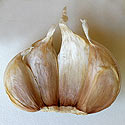 |
|
Allium schoenoprasum (Chives)
Family:
Alliaceae
Native to Europe and Asia and believed to have been
domesticated within the Mediterranean region. The earliest records of cultivated
chives go back to only the 16th century. The leaves of chives are have a mild
flavour and are cut up and added to salads, egg dishes, meat dishes, sauces and
cottage cheese. |
|
|
Anethum graveolens (Dill)
Family: Apiaceae
Dill is an annual or biennial herb that is native to southwestern
Asia and southern Europe. Fresh leaves are chopped up and added to salads or
used in seasoning fish dishes. The seed-like fruit are used in pickling
gherkins or added to butter ('dill butter'), vinegars, cheeses, bread,
vegetables and sauces. |
|
|
Angelica archangelica (Garden angelica)
Family: Apiaceae
Angelica is native to Europe and Asia and is cultivated in
southern Africa, although commercial cultivation is mainly in Europe. Leaves are eaten as a vegetable and the petioles and
inflorescence stems are candied (usually coloured green) for cake decoration. It
is used as a tonic and flavouring in wines and spirits (gin, chartreuse,
Bénédictine, vermouth and vespétro). |
|
|
Anthriscus cerefolium (Chervil)
Family: Apiaceae
Chervil is an annual herb native to Central Asia, from
Iran to southern Russia. Leaves can look rather like those of parsley. It
was cultivated as a cullinary herb at least from Greek and Roman times.
Along with parsley, tarragon and chives, it is one of the components of
fines herbes used by French chefs. Fresh and dried leaves are used in
soups, fish dishes, egg dishes, sauces (e.g. bèarnaise and
gribiche), and as a constituent in salad dressings. |
|
|
Armoracia rusticana (Horseradish)
Family:
Brassicaceae
Horseradish is a pungent herb with leaves that are
used in salads and sandwiches, and roots that are used for sauces that are added
to meat. It is also used for various medical complaints. It is a sterile
cultigen thought to have originated in
southern Russia and Eastern Ukraine. It has become naturalised in Europe, North
America and New Zealand, where it can be found growing along roadsides.
Cultivation dates back only to about Roman and Greek times, about 2000 years
ago. |
|
|
Artemisia
dracunculus (French tarragon)
Native to Eurasia. It is a very important cullinary
herb in French cooking and is one of the four ingredients in fines herbes
(the other three being
parsley, chervil
and chives). It
is added to white wine vinegar to produce tarragon vinegar, which is used in
salads, sauces, pickles and with fish. Fresh leaves are used to flavour
meat, chicken and egg dishes, as well as sauces (including béarnaise,
hollandaise and tartare) (van Wyk 2005). |
|
Borago officinalis (Borage) Family:
Boraginaceae
Believed to be native to the Middle East but ocurs naturally in southern
Europe and the Mediterranean region. Grown as a garden herb. The leaves and
flowers are used more for decorating drinks (e.g. gin) and food (e.g.
salads) than for consumption. Flowers are sometimes crystalised and used to
decorate puddings and cakes. Oil is extracted from the seeds and used as a
dietary supplement (termed "starflower oil") because it contains very high
levels (21%) of unsaturated gamma-linolenic acid (GLA), which is an
essential fatty acid. |
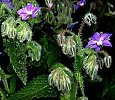
|
|
Brassica nigra (Black
Mustard)
Family:
Brassicaceae
|
|
|
Brassica juncea (Indian or Brown Mustard)
Family:
Brassicaceae
|
|
|
Capparis spinosa (Capers)
Family:
Capparaceae
Native to Asia Minor and the Mediterranean region.
Capers are the unopened buds of this plant, pickled in white wine vinegar
(Sicilian capers are pickled in brine). Capers are used to flavour
many foods including fish, meat, rice, or as garnish for e.g. pizzas. |
|
|
Capsicum annuum (Paprika pepper)
Peppers orginate from Central America where most of the
main varieties (sweet and chilli/pungent) were developed by local Indians. Once peppers were discovered by
the Spaniards and Portuguese they were rapidly introduced worldwide and eagerly
incorporated into local cuisines. Paprika pepper is derived from the dried,
ground up fruit of the Paprka chilli cultivar. |
|
|
Capsicum frutescens (Cayenne pepper, Tabasco pepper, Red pepper)
A perennial herb that originates from Central and South
America. There are two main cultivars namely 'Tabasco', which is used to
make Tabasco sauce, and 'Habanero', which is claimed to be the hottest of
all chillis. Cayenne pepper and red pepper are derived from the dried
powdered fruits. |
|
|
Carum carvi (Caraway)
Family: Apiaceae
Native to the Mediterranean region, central Europe and
western and eastern Asia. It has been used since ancient times to flavour a
wide variety of foods, including stews, sauerkraut, cheeses, breads and
biscuits. It is also an ingredient in the following alcoholic drinks:
aquavit, kümmel, schnapps and Vespétro. |
|
|
Cinnamomum aromaticum (Chinese cinnamon, cassia
bark)
Family:
Lauraceae
The bark is used in a similar manner to true cinnamon bark
from Cinnamomum
verum. It has a stronger flavour than true cinnamon and is cheaper
so is quite often used as a substitute for the latter. |
|
|
Cinnamomum verum (Cinnamon)
Family:
Lauraceae
This medium-sized tree is
the source of true cinnamon and is native to Sri Lanka and India. The spice is derived from the bark
and has a sweet, spicy flavour. It is used in puddings, confectionery,
mulled wine, sauces, red meat dishes, chicken dishes, pickles and soups. The
flavour is mainly due to cinnamaldehyde, which is the main component in the
essential oil derived from cinnamon. |
|
|
Coriander sativum (Coriander, Cilantro)
Family: Apiaceae
Originates from the eastern Mediterranean region and
western Asia and has a long history of cultivation. Coriander leaves are
used to flavour a wide variety of dishes including soups, guacamole and
fish. The fruits are used as a spice in pickles, vegetable dishes, soups and
marinades and are an ingredient in curry powder. They are also used in
baking (e.g. bread and biscuits) and for flavouring alcoholic drinks such as
Chartreuse and Izarra. The leaves have good levels of calcium, phosphorus,
vitamin A and vitamin C. |
|
|
Crocus sativus (Saffron)
Family:
Iridaceae
Native to southern Europe and southwestern Asia.
Saffron is derived from the stigmas and styles of this flower. Flowers are
cultivated on a massive scale (mainly in Spain) as it takes 150 000 flowers
to produce 1 kg of dry spice. It is not cultivated in southern Africa. Not
surprisingly, saffron is very expensive and is often adulterated with (or
substituted by) safflower (False saffron) or Turmeric (Indian saffron).
Saffron is used as a flavourant and reddish-coloured dye in e.g. cheeses,
butter and confectionery. It is an ingredient in the Spanish dish paella
and in Indian curry and rice dishes. Saffron has the highest known levels of
vitamin B2 of any plant product. |
|
|
Cuminum cyminum (Cumin)
Family: Apiaceae
|
|
|
Curcuma longa (Turmeric)
Family: Zingiberaceae
|
|
|
Elettaria cardamomum (Cardamom)
Family: Zingiberaceae
|
|
|
Foeniculum vulgare (Fennel)
Family: Apiaceae
|
|
|
Laurus nobilis (Bay leaves)
Family:
Lauraceae
|
|
|
Myristica fragrans (Nutmeg and Mace)
|
|
|
Ocimum basilicum (Basil)
Family:
Lamiaceae
|
|
|
Origanum majorana (Marjoram)
Family:
Lamiaceae
|
|
|
Origanum vulgare (Oregano)
Family:
Lamiaceae
|
|
|
Papaver rhoeas (Poppy seeds)
Family:
Papaveraceae
|
|
|
Petroselinum crispum (Parsley)
Family: Apiaceae
|
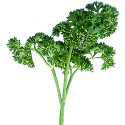 |
|
Pimenta dioica (Allspice)
Family:
Myrtaceae
|
|
|
Pimpinella anisum (Anise)
Family: Apiaceae
|
|
|
Piper nigrum (Pepper)
Family:
Piperaceae
|
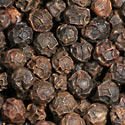 |
|
Rosmarinus officinalis (Rosemary)
Family:
Lamiaceae
|
|
|
Salvia officinalis (Sage)
Family:
Lamiaceae
|
|
|
Satureja hortensis (Summer Savory)
Family:
Lamiaceae
|
|
|
Satureja montana (Winter Savory)
Family:
Lamiaceae
|
|
|
Sesamum indicum (Sesame)
Family:
Pedaliaceae
|
|
|
Sinapis alba (White Mustard)
Family:
Brassicaceae
|
|
|
Syzygium aromaticum (Cloves)
Family:
Myrtaceae
|
|
|
Thymus spp. (Thyme)
Family:
Lamiaceae
|
|
|
Trigonella foenum-graecum (Fenugreek)
Family:
Fabaceae
|
|
|
Vanilla planifolia (Vanilla)
Family:
Orchidaceae
|
|
|
Zingiber officinale (Ginger)
Family: Zingiberaceae
|
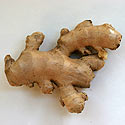 |
|
|
|
